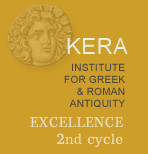Main Site . Sebasteion
13. Dedication of a statue of Commodus (?)
![]()
| Ἀντωνεῖνον |
Antoninus
Inscription on the pedestal at the north wall of the Sebasteion. The inscription occupies parts of blocks E 7 and E 8.
Letters: 4.5-5 cm.
Jones 1979, no. 7 (pl. 77.1); SEG 27 (1977), 927; İnan 1993, pp. 222-225, no. 5 (pl. XIII, E cf. pl. XV).
There is a line after the final nu to the right below, that looks like a horizontal stroke. It may be accidental, as no other traces of erased letters are visible.
It is likely that the emperor refered to here is Commodus, the last Antonine whose favorable response to the Lycian league's decision to reward Boubon for its role against brigands figured prominently in or near the theater (no. 5). İnan suggests that a larger than life statue apparently belonging to the Sebasteion bronzes was that of Commodus and stood, originally, on the pediment above this inscription2 (İnan, op. cit., p. 225 and pl. XXIX.33). Queyrel, however, assigns a Hellenistic date to the torsο (Queyrel 2003, pp. 117-118, no. 5). There is an inscription with the letters ATTA incised in the bronze of the torso which has received various interpretations (no. 22b). The style of the letters of the dedicatory inscription on the podium, especially the form of the omega, is very similar to that of the inscriptions for Marcus Aurelius and Lucius Verus. The brevity of the inscription is most likely intentional, as a way to emphasize the reigning emperor's greatness. A dedicatory inscription consisting of just one word may suggest to the viewer that this was the Antonine emperor, immediately recognizable through his divine aura (and the size of the statue), no further titles or details needed. After his damnatio memoriae Commodus was rehabilitated by Septimius Severus, but it would come as no surprise if his disgrace had had little effect in Boubon in the first place. His honorable treatment of the city need not have been forgotten after his death. On provincial attitudes to Commodus, see Hekster 2002, pp. 83-85 and 168-?. On his portraits not having been re-cut, see Varner 2004, pp. 136-155. Commodus was honored with a statue and similarly laconic inscription in neighboring Oinoanda; Milner and Eilers 2006, pp. 73-74.
To the left of this dedication there was apparently a large uninscribed space. On part of E 6 there are traces of erased lines (see no. 10), but other than that, the stone seems to have been uninscribed. E 7 is a large block that carries only the letters Ἀντωνε- belonging to the inscription (presumably) for Commodus. Also block E 13, resting on top of E 6 and E 7, seems to have been largely uninscribed. To explain this gap, İnan, op. cit., p. 223, has suggested that, originally, a statue of Commodus' wife Crispina had been erected to his right. According to this explanation, Crispina's statue was set up shortly before her disgrace and exile, and was thereupon removed without the base of her statue ever receiving an inscription. Given the state of our evidence, this seems a possible, though speculative explanation.

